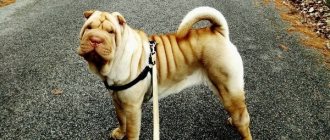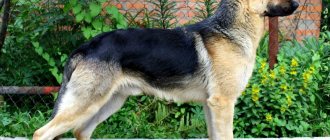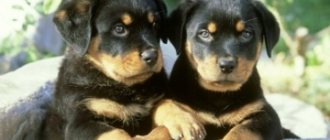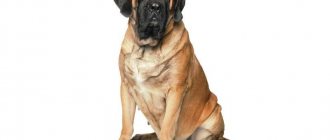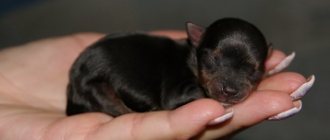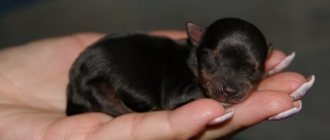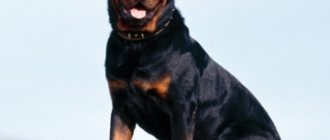Back in the eighties of the last century, representatives of the Shar Pei breed were included in the Guinness Book of Records as the rarest dogs. Now they have become recognizable all over the world. DNA studies have shown that dogs have lived on the planet for more than three thousand years. This is a very old Chinese fighting breed. They were originally bred in China for dog fighting. Their loose, folded skin made it possible for them to slip out in a fight without being seriously injured. They were then bred and used for guarding and hunting.
According to Chinese beliefs, the Shar Pei's blue tongue, like an amulet, can scare away evil spirits. During the Second World War, the dog almost disappeared, as the animal tax introduced in China made it a luxury item. However, today it has become very popular.
Advertising:
The word “Shar Pei” is translated as “sand skin” and this is due to the fact that their fur is hard and short, reminiscent of a type of grainy, prickly sand.
Breed characteristics
| Short description | |
| Origin: | China |
| Conditions of detention: | Any conditions other than constantly being on the street |
| Purpose: | Companion, home security |
| Color: | Almost all types of solid colors except all white, with or without black mask |
| Wool length: | From 0.8 cm to 2.6 cm |
| Adult dog size: | Height from 44 to 52 cm, weight 20 – 25 kg |
| Average life expectancy: | 9 – 11 years |
| Walk: | Mandatory, at least twice a day |
| Physical activity needs: | Average need, from one and a half to two hours a day |
| Fédération Cynologique Internationale (FIC) classification: | Group 2: Pinscher and Schnauzer, Molosser, Mountain and Swiss Cattle Dogs; Section 2: Molossians |
| Puppy price: | From 10,000 rubles “sofa” puppies, up to 50,000 rubles show class |
How long do Shar Peis live?
The average lifespan of a purebred Shar Pei is 10 years.
The life expectancy of a Shar Pei living at home is influenced by the following factors:
- Heredity.
- Dimensions. The larger the animal, the more energy the body expends to maintain its vital functions.
- Compliance by owners with the rules of keeping a dog.
- Regularity of sexual activity and number of births for females.
History of the origin of the species
It is not known for certain where the history of the origin of the Shar Pei began . It has just been established that this is one of the oldest breeds. The first mentions of these dogs are found already in 206 BC. During archaeological excavations, figurines of dogs were found that were very similar to today's Shar Pei.
Representatives of the Shar Pei breed are among the top 5 most ancient dogs. The Shar Pei is believed to be a direct descendant of one of the 4 basic aboriginal breeds from which all current dogs descend.
The Chinese have a comic legend. They say that before, Shar Peis weighed about 80 kilograms. In the process of evolution, the dog became smaller, but the skin remained the same size, hence their folds.
According to one version, representatives of the breed descended from ancient smooth-haired Chow Chows, and it was from them that the Shar Pei acquired a blue tongue. The Chinese believe that the blue tongue, like an amulet, wards off evil spirits.
In the 60s, due to the policies of communist China, dogs were declared an unaffordable luxury that took away a piece of bread from the working people. Owners and breeders were taxed, and the number of breeding dogs began to decline rapidly.
By the late 60s, only a few individuals remained in Hong Kong. Then, one of the connoisseurs of the breed turned to the USA for help, and thus saved the Shar-Pei from extinction. The dogs were taken to the United States. In order to increase the number of livestock, Chow Chows were mixed with Shar Peis, thereby obtaining a modern type, heavier, with brushed hair.
In China, Shar-Peis are still lighter, with horse-hair. At the moment, the FCI is raising the question of dividing the breed into 2 types - American and Chinese.
The Shar Pei was listed in the Guinness Book of Records as the rarest breed in 1978 . But thanks to enthusiasts who worked to restore the breed, by 1983 it was reborn. Now their genes contain the blood of not only chow-chows, but also bullmastiffs, bulldogs, boxers and bull terriers.
The history of these dogs in Russia began in 1991 . The first breeding pair were imported but, unfortunately, these natives died. A repeat attempt was successful in 1993. It was possible to obtain offspring from the imported couple.
Development from 1 to 12 months
| Age | Weight, kg | Height at withers, cm |
| 1 month | 3-3,5 | 21-23 |
| 2 months | 5-8 | 29-30 |
| 3 months | 8-10 | 33-35 |
| 4 months | 11-14 | 35-38 |
| 5 months | 15-17 | 38-39 |
| 6 months | 18-19 | 39-41 |
| 7 months | 19-21 | 41-44 |
| 8 months | 19-22 | 44-47 |
| 9 months | 22-24 | 47-48 |
| 10 months | Approximately 25 | 48-51 |
Data on the height and weight of puppies are averaged and minor discrepancies with them are not a cause for concern .
However, if the puppy’s body weight is significantly higher than average, it is important to make sure that he does not have developmental disabilities or obesity - Shar Pei are prone to overeating and gaining excess weight.
The length of the body should be almost equal to the height of the puppy at the withers.
Distinctive features
The main breed traits of the Shar Pei:
- Height. The height at the withers for females is from 44 to 50 cm, for males from 46 to 52 cm.
- General form. A compact dog with strong bones, moderate sanding, but clearly visible.
- Head. Relative to the body, it is large, brick-shaped, flattened, with a well-filled cushion. bite , tongue and palate blue. The ears are small, triangular, the tips of the ears are slightly turned up (ideal standard). Small, deep-set eyes , brown in color, lighter ones are allowed in delta colors. The muzzle is wide, does not narrow toward the nose, and has fleshy chins that cover the lower jaw.
- Neck. Moderately short, strong, strong with good dewlap
- Frame. Square format. The back is straight, without arching, strong and wide. The loin is short and wide. The chest is deep and wide. The stomach is moderately tucked.
- Limbs. Straight, squat, strong, parallel to each other. The shoulder is sloping, with well-defined muscles. Hock joints dropped.
- Tail. Set high, short, thick at the base, tapering towards the end. It is twisted into a ring over the back.
- Coat and color. Two types of coats: horse - coat length up to 1 cm; brush – the length of the coat is from 1 to 2.5 cm. There is no undercoat, the outer coat is hard. Almost all basic colors are acceptable, except solid white. All types of delta colors, except completely white.
- Sexual dimorphism. Weakly expressed, but its presence is welcome.
Shar Pei color
In 2005, the Russian Canine Federation approved a register of Shar Pei colors that meet the standards.
The color of the Shar Pei, according to the adopted document, must have the following distinctive features:
- wool is one color. Spots are allowed in white Shar-Peis;
- hind legs are half a tone lighter than the main color;
- the dog's muzzle is slightly darkened;
- A dark stripe in the form of a ribbon is allowed on the back.
It is impossible to describe the entire amazing palette of colors that Shar Peis have. But it is conditionally divided into three parts:
- Main color
- Diluted color
- Unusual color (otherwise called marriage)
The dominant color in the first group is black. Moreover, natural blackness in animals is quite a rare phenomenon. As the puppy grows up, it changes color and instead of black, its coat acquires a brown, brown or olive tint.
The first group includes dogs with the following color scheme:
Cream. Dogs of this color have weak pigmentation; the back, eyes, ears and tail are darker than the main color.
Deer. The oldest color of an animal. A distinctive feature of the wool is a golden shine that shimmers in bright light. As the individual grows older, the color changes to darker.
Red deer. A variety of deer color. Unlike golden fawn, red fawn puppies have dark red or faint light red undertones in their fur.
Isabella. A puppy of this color will win the heart of the owner forever, being the offspring of red and blue specimens, he has a pinkish-cream coat without red pigment with a sky-blue tone.
Red. The most popular tone among breeders. Its varieties are red, red and mahogany tones.
The Blue Shar Pei has an aristocratic appearance. Blue color is a combined concept that includes animal smoky, gray and slate shades.
Sable. At first glance, an animal of this color seems to be sprinkled with grayish pollen, and the spraying was more intense in the areas of the back, tail and muzzle. Taking a closer look, you can see that each hair consists of three parts - light at the bottom, then red, and dark at the tip. The sable color differs from other colors in the presence of zones.
In dilute-colored animals, the black color is completely absent. The group's palette is represented by the following colors:
Cream (creamy shade). Unlike its counterpart from the first group, the cream dilut does not have a dark color on the back and ears, and there is no mask on the face. Their tongue color is lavender and their nose is pink.
Apricot. The color of the fur is golden-red. The play of color from the dark back to the light belly is touching. The pet can be one color. The nose is usually chocolate color.
Red. Dogs of this color have a mask on their muzzle, nose and pads that have a delicate chocolate tint. Regardless of the age of the dog, the color of the dog’s body is uniform.
Chocolate. You can match the animal to the color of your favorite delicacy, due to the fact that the color tone varies from milky to dark. The chocolate dog's tongue is light lilac. If an individual has a blue tongue and a dark color, it is not a chocolate dilute, but a representative of the first group.
Lilac. The dogs are a rare color and have a bluish coating on their faces. Coat color can be chocolate pink, silver pink or dark purple.
Isabella. The rarest color of the Shar Pei, according to the standard a mask is allowed on the face. A characteristic feature of dogs of this shade is the absence of darkening on the back.
Pets of unusual color are called floral, due to the spots they have on their body. Such species are becoming more and more attractive, but are not recognized by all cynological federations. The application submitted to the RKF for inclusion in the register of spotted sharpei colors has not yet received confirmation.
Photo of an adult dog
When is weaning from the mother?
At the age of 3 weeks, puppies already have quite sharp teeth and claws, with which they can scratch and bite the bitch while eating, so it becomes difficult for her to feed them and she increasingly leaves the babies.
Puppies should not be specially separated from their mother - she not only feeds them, but also raises them and passes on antibodies that help strengthen the babies’ immune system and help them fight diseases.
However, by 2 months of age, the mother's connection with the puppies should be minimal, they should be able to eat and play independently, otherwise they will be unprepared for life and moving to a new home.
Photos of puppies
Breeding
Only absolutely healthy dogs that meet the breed standard can participate in breeding.
For a female, the optimal age for mating is approximately 1.5 years; a male is ready for mating at 1.5-2 years.
Estrus
Estrus indicates the beginning of puberty. At this time, eggs mature in the genitals and the dog is ready for fertilization and pregnancy. The first estrus occurs at approximately 6-10 months; its onset can be judged by the appearance of drops of blood at the tip of the loop.
Mating
A bitch should be bred no earlier than she is 1.5-2 years old, i.e. only in her 3rd heat. The optimal time for mating is the 11th, 13th or 15th day of estrus, when the discharge becomes light pink rather than bloody, and the loop becomes soft.
Before mating, it is necessary to carry out deworming, treatment for external parasites and, if necessary, vaccination.
Gestational age
During the first 2-3 weeks, there are no noticeable changes in the dog’s body; the fact that the mating was successful can only be judged by minor changes in behavior.
The pregnancy of a Shar Pei lasts 60-65 days; 3-6 puppies are most often born in a litter, but in some cases there can be 12.
Childbirth
Before giving birth, the dog refuses to eat, its body temperature drops to 36.5 °C, it behaves restlessly, trembles, breathes quickly, tries to hide, scratches the floor and bedding, trying to make a den for itself.
First, the dog’s water breaks, then pushing begins and the cervix dilates.
The puppy is born in the amniotic sac. If the bitch does not chew it, you need to tear the bag yourself in the area of the baby’s head, and then clean his mouth of mucus with a napkin. Then you need to tie and cut the umbilical cord.
If the bitch gives birth for the first time, it is necessary for a veterinarian to be present at the birth.
Sterilization and castration
Sterilization and castration are recommended for individuals that are not intended to be used for breeding. These procedures are not contraindicated for dogs; on the contrary, animals who undergo them have better health and a longer life expectancy.
The operation can be performed after the dog is six months old. It is better to spay a bitch before her 1st or between 1st and 2nd heat. This is due to the fact that sterilization is a way to prevent mammary cancer, but later it is also not prohibited to spay and neuter dogs.
It may seem that caring for Shar-Peis is difficult, but this is not entirely true. You just need to find an approach to the dog, accustom it to all hygiene procedures and, most importantly, treat it with love and care. Then the Shar Pei will grow up to be a healthy, beautiful and devoted friend and protector.
Features of character and behavior
Shar Peis are called philosopher dogs, this speaks volumes about their behavior. Calm, balanced, thinking, independent, independent and unobtrusive friends of a person. They do not like fuss, are not inclined to conservatism, are leisurely, even a little imposing - these are the real breed traits of the Molossian aborigines.
Many people believe that Shar Peis are stupid dogs due to their training habits. But the Chinese, who call them thinkers, say that the labyrinths of the mind appear on their foreheads.
Many are sure that the Shar Pei is a fighting breed; in Russia and Belarus it is included in the list of potentially dangerous dogs, but this is complete nonsense.
Due to the movable skin, they were actually tried to be used in battles in the 17th century, but this idea was soon abandoned due to the lack of aggression. Moreover, not a single canine organization in the world recognizes such a thing as a “fighting breed”.
The Shar Pei is an absolutely versatile dog. Previously, they were used for hunting, protecting houses and livestock. We fought against mongooses that attacked peasant birds. For a short time they were even used as shepherds. Today it is a companion dog. People who have encountered a Shar Pei at least once call them thinking or understanding companions.
Treats strangers arrogantly, with distrust, but without aggression . With a good level of socialization, he does not show aggression at all. But in the manifestation of his feelings he will be restrained, like a true eastern sage. If the dog is in complete social deprivation, or rarely leaves the territory of its territory, it may exhibit protective qualities.
They love their family members endlessly, although sometimes they can be stubborn. Children are treated tolerantly, especially female Shar Peis. The maternal instinct in female dogs is so developed that they can become excellent nannies for a child.
They may seem a little phlegmatic or even melancholic, do not fetch fetch, and are indifferent to toys after changing teeth. But during hunting or playing with their brothers, they turn into playful, perky puppies. It becomes unclear where these lazy people get so much energy.
There may be some difficulties in communicating with brothers.
Shar-Peis, especially during the growth period, have a rather loose structure of the nasopharynx; with rapid breathing, wheezing can be heard, which some dogs may perceive as a growl and respond with aggression.
In addition, Shar Pei has a rather specific smell that is not characteristic of domesticated dogs. Representatives of this breed are recommended to make friends who are the same age since childhood, then there will be no problems.
Advantages
The Shar Pei has many advantages. A very smart, calm, balanced dog. A true Eastern philosopher, with all that implies. He doesn’t make unnecessary movements, doesn’t show aggression, knows how to restrain his emotions, and doesn’t impose his company. He even has some intelligence, aristocracy and neatness.
The French have a saying: “If you walk down the street with a Shar Pei, don’t be surprised if no one notices you.”
The main advantage of the Shar Pei is its appearance. A dog of extraordinary beauty, incredibly cute and unusual exterior. Literally translated, “Shar Pei” means a sand dog; when you pet them, you get the feeling that sand is rolling in your hands.
Flaws
Not suitable for sports training, obeys commands lazily and reluctantly. Before carrying out an order, he must be given time to think. He has a stubborn temperament and an independent character. Speaking in “human” characteristics, he is touchy. Absolutely not suitable for any types of services (police, Ministry of Emergency Situations, etc.).
Modern standard
Along with the battles, the need to breed the most folded individuals has become a thing of the past. Despite the fact that it is very beautiful and unusual, this exterior also has its disadvantages.
Shar Pei is a puppy that requires increased care and special nutrition. He is prone to allergic reactions, the consequences of which are very difficult to cure due to the fact that in the skin folds any bacteria feels like in a greenhouse, and therefore multiplies at enormous speed.
Chic, plush dogs have been replaced by dogs of a drier type. Today, this is a whole trend in the activity of breeders and it leads to the fact that taller, leaner dogs appear on the streets, having folds only on the muzzle and along the back (in some representatives they are preserved only on the forehead). Of course, this is more practical, the dog becomes less susceptible to various dermatological diseases, but from an aesthetic point of view, unfortunately, it loses a lot.
Care and maintenance
The Shar Pei is not fussy about keeping. Can be kept in a small apartment, with two walks a day. And in a private house, with the condition of living in a warm room.
Shar Peis do not have an undercoat, so prolonged exposure to the street leads to hypothermia - in the cold season, to overheating - in the heat.
There is an opinion that Shar Peis need special care because of their wrinkles. That the skin between the folds is rotting, has an unpleasant odor and needs to be wiped every day. It is a myth! This dog's wrinkles are a natural condition and do not require any special care.
The dog's eyes require careful attention. Small puppies have much more folds than adults. Sometimes wrinkles interfere with deep-set eyes; the upper eyelid can completely cover the eyeball. For this purpose, veterinary clinics have several special procedures that solve this problem once and for all. The owner will only have to regularly wipe the pet’s eyes with a sponge soaked in a special lotion.
Shar Pei ears, in the absence of any diseases, do not need deep cleaning. It is necessary to wipe only the upper part of the ear from dust. If there are signs of otitis, deep cleaning is also not performed. The suspension is instilled into the ear, without rubbing with cotton swabs or other equipment.
Nails should be trimmed as needed. This must be done carefully, without damaging the internal living tissue. A breeder, groomer, or veterinarian can show you how to do this correctly.
During the period of teeth change, the dog should have “chew” toys. They help loose baby teeth fall out and avoid crooked molars. You can use either special toys from a pet store or large beef bones. An uncut beef rib or large knuckle bones are ideal. In any case, the bone should be of such a size that the puppy cannot swallow it or choke on it.
Nutrition
Shar Pei breeders encourage feeding them with ready-made grain-free food. Premium, super premium or holistic food.
These are fully balanced diets for dogs, enriched with all the necessary vitamins and minerals for the healthy development of the dog.
It is quite difficult to independently create a truly correct diet for a Shar Pei, especially in the first year of life. This breed, despite its compact appearance, is a giant-growing dog and reaches the size of an adult by 6–7 months. During the period of active growth, the foundation for the pet’s health is laid. An incorrectly selected diet can lead to serious consequences with the bones or immune system. Therefore, you should not take risks; it is better to entrust food to professionals.
All food manufacturers indicate the amount of food consumed per day depending on the dog’s weight. Food for puppies and adults should be different; to select the correct diet, you must contact the breeder.
We recommend that you read a detailed article on the topic: “How and what to feed a dog: types and characteristics of nutrition.”
Health
Until the beginning of the 21st century, Shar Peis were considered one of the sickest dogs. Gradually, thanks to conscientious breeders and nursery owners who do not allow sick animals into breeding, the breed has become much healthier.
The time of countless allergies, pathologies and curvatures of the limbs, constant otitis media and entropion of the eyelids has passed. Of course, all these diseases still occur in Shar-Peis, but much less frequently.
With the right approach to feeding and raising a puppy, many health problems can be avoided. To do this, you need to carefully listen to the recommendations of veterinarians and the breeder.
Vaccinations
The vaccination schedule is the same for all breeds. At approximately 6 weeks , the entire litter is dewormed along with the mother. After two weeks, the breeder repeats the procedure for preventing helminths.
Only after this is the first vaccine against viral infections such as Carré's disease, enteritis and hepatitis given. Depending on the region, the veterinarian may recommend an additional vaccine against the virus that lives in a particular area. After about 4 weeks, the vaccine is duplicated to consolidate the effect.
By this time, you can already get vaccinated against rabies. The last injection is given at the age of 7 to 12 months with the same vaccine. Further, the drugs are injected once a year along with anti-rabies serum.
Until the puppies have received their second vaccination, quarantine must be observed.
Communication with other dogs is prohibited, with the exception of the mother and littermates. Taking the puppy outside is also prohibited.
If your pet feels unwell on the day of helminth prevention or after vaccination, do not be alarmed - this is a natural reaction to the drug. Lethargy, drowsiness, one-time or two-time refusal to feed, and a slight increase in body temperature by 0.5 - 1 degree .
Allergic reactions are possible in theory, but in practice they are very rare.
Important article on the topic: “Everything you need to know about dog vaccinations.”
Diseases
The most common diseases in Shar Pei:
- Otitis;
- Allergy;
- Entropy;
- Amyloidosis
- Entropy;
- Entropion;
- Atopy;
- Enteritis;
- Intertrigo;
- Seborrhea;
This is not a complete list of diseases that Shar Pei can suffer from. The main problem areas are the eyes, ears, and skin . But, as mentioned above, diseases are becoming less common, thanks to the painstaking work of breeders.
Breeders recommend that upon reaching 4 years of age, they undergo an examination every year at a veterinary clinic, take a urine test and a biochemical blood test. In order to identify possible diseases in the primary stages and get rid of them as quickly as possible.
Walk
Shar Peis do not require special walking conditions. Despite the lack of undercoat, there is no need to dress them in winter; they can easily tolerate a couple of hours in the cold.
A walk of 40 to 60 minutes twice a day is enough for them Shar Peis are not very active dogs; a short, leisurely walk is enough for them.
Puppies up to one and a half years old need a little more time to splash out their energy. After that one hour is enough.
Grooming
Careful grooming is not required . Due to the lack of undercoat and short guard hair. In spring and autumn, during the molting period, it is necessary to free the dog from dead hairs with a furminator a couple of times a week. The rest of the time, no more than once a month.
There is no need to wash your Shar Pei at all in winter, so as not to wash away the natural fatty film on the skin, which prevents the dog from freezing. In spring and autumn, after walks, you can rinse your stomach and paws from dirt. Fully washing more than once a month is not recommended.
Vaccination
Dogs are vaccinated according to the standard schedule:
- 8-9 weeks: complex vaccine against distemper, parvovirus enteritis, viral hepatitis, leptospirosis, parainfluenza;
- after 2-3 weeks: vaccination with the same vaccine;
- 6-7 months (after changing teeth): rabies vaccination;
- 12 months: comprehensive vaccination.
In the future, Shar Peis are revaccinated every year.
After vaccination, dogs need especially careful care. They should not be taken outside, allowed contact with other animals, left in a draft, or exposed to stress.
For your information. The vaccination schedule can be changed by your veterinarian.
Mating
Mating is allowed for males aged 18 months and older. Bitches are at 4 sexual estrus, but not earlier than they are one and a half years old. The dog must have time to fully develop to avoid problems with the bones.
Sick individuals or those with disqualifying exterior defects are strictly not allowed for breeding.
A male dog can inseminate at least every month. Bitches are prohibited from being bred more than once a year; this will lead to exhaustion of the body and a high probability of giving birth to sick offspring.
Estrus occurs on average, as in all breeds, on the 10th – 14th day of estrus. Depending on the individual characteristics of the organism, these data may vary from -2 to +4 days .
Read a detailed article on the topic: “Everything you need to know about breeding dogs: appropriate age, what to do if it doesn’t work out, rules and tips.”
Is a muzzle necessary?
To understand whether Shar Peis need a muzzle, you need to remember for what purposes this breed was originally used and for what purposes it is used now.
In ancient times, Shar Peis were a fighting breed of dog, but now they are excellent watchmen and security guards. That is, they may well show aggression if they feel threatened. For this reason, no matter how confident you are in your dog, it is by no means decorative, which means it will need a muzzle.
You can make a muzzle to order or buy a ready-made one in a special store.
IMPORTANT!
To choose the right muzzle, you must know the length of the muzzle, skull and head circumference. Together with these indicators, you can choose a muzzle in consultation with the seller.
Also, do not choose an iron one - it can be traumatic for the animal itself and for humans. It is better to opt for leather.
You need to wear a muzzle in crowded places.
Key points in training
Aboriginal breeds, which include the Shar Pei, are considered one of the most difficult to train. It is not recommended for beginners in dog breeding to engage in training on their own. It is necessary to contact professional dog handlers and animal psychologists who work on the basis of conflict-free training. Or raise a pet under the strict guidance of a breeder.
This breed needs to be able to be interested in activities, then you can get a well-bred dog.
Read about how to properly train a dog in the article: “Training a puppy: effective methods from dog handlers, learning commands at home.”
Dry food
Economy grade foods such as Pedigree, Chappi, Darling, ARO should be avoided. Only high-quality products are suitable for feeding Shar Peis.
The following brands of food are popular among breeders: Go Natural Grain Free Endurance, Happy Dog Supreme Junior, Orijen, Canidae, Nutra Gold, Pro Plan, Hills, Royal Canin Medium Junior, Eukanuba puppy, Almo Nature Small Puppy, Summit Holistic Original Puppy.
How to choose a puppy
The main criterion in choosing a puppy, not only a Shar Pei, but any other breed, is health. It is necessary to remember that sick parents will not give healthy offspring. It is important to pay attention to the health status of the future pet’s parents and littermates. There should be no “sores” on the skin, discharge from the eyes, ears, or nose. Puppies should be moderately well-fed, strong, playful, and inquisitive.
You cannot buy a puppy of “elite blood” at the poultry market . You need to choose only reputable breeders or large nurseries.
At the time of sale, the puppy must have a puppy card or pedigree and a veterinary passport indicating all manipulations carried out with the puppy.
You should buy a dog only after passing the first stage of socialization - no earlier than 2 months of age.
Shar Pei is a dog for calm, balanced, strong-willed people. You cannot treat the Molosser as a toy, otherwise it will show the true character of the native. Shar Pei demands respect for himself, and the relationship is equal, only then will he respond in kind.
5 / 5 ( 1 voice )
First impression
At first glance, these dogs are clumsy and clumsy, but at the same time very funny. And not all of them can be called sofa-like. There are quite athletic and active Shar Peis, but they are all as one – cute and very affectionate with their owners. This dog will never harm even a small child, allowing him to finger his soft folds for as long as he wants.
Shar Pei is a very attractive puppy in appearance. It is in children that the folds are especially pronounced. If you lift the baby on your palms, the heavy folds will even hang down a little from them. It is they who provide the breed with incredible popularity.
Tongue color
In Shar Peis, which belong to the main color group, the color of the tongue can only be bluish-black. In dilute colors, a lighter shade is allowed. The color of the tongue can be seen even in puppies, but some have poorly expressed pigmentation at a young age.
Important! Adult Shar Pei's tongue should be one solid color with no spots.
Shar Peis have many external distinctive features that set the breed apart from the rest. Animal lovers know that the dog with the folds is, of course, the Shar Pei. All distinctive features and characteristics are specified in the breed standard. Any discrepancies do not allow animals to participate in show class exhibitions.
